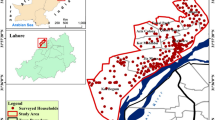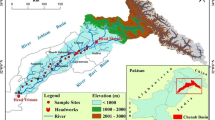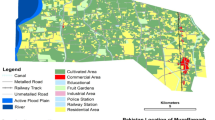Abstract
The paper assesses the damage caused by 2010 flash flood and its underlying causes in the upper zone of Panjkora River within district Dir Upper, Khyber Pakhtunkhwa (KP) Province in Pakistan. Floods in general and flash floods in particular are very common in the area, and the phenomenon has intensified in the wake of observed climatic changes in the region. Anticipating an increase in the multiplicity of causes and a rise in the human, livelihood, and property losses attributed to flash floods calls for a detailed study of affected communities in the region. Within the study area of District Dir Upper—within the band of 200 m on both sides of Panjkora River, three most affected communities, namely Barikot, Kalkot, and Sharingal, were picked on random basis to have detailed analysis of underlying causes and the quantification of damage assessment in the area. Questionnaire-based household survey and structured interviews were conducted to investigate physical and economic damages in the sample sites. Global positioning system (GPS) survey is also conducted to acquire absolute location of damages, and geographic information system is used to visualize land use, land cover, physical features, and GPS data. Monsoon winds interacted with the westerlies abnormally caused unprecedented high intensity rainfall in the valley. The steep topography of the area caused rainwater to accumulate rapidly in the Panjkora River channel, overpowering the withholding capacity of the river. The flash flood inflected heavy losses to life and properties of the local population. The infrastructure such as houses, roads, retaining walls, bridges, water supply schemes, and irrigation channels were destroyed severely in the whole area particularly in Kalkot. Three explored underlying causes of flash floods and the degree of damage due to 2010 flash floods in the region call for an enhanced realization for climatic change adaptability, flood risk management, and mitigation measures, better flood response through early warning systems, and improved rehabilitation and recovery efforts within flood prone areas such as district Dir Upper, KP, Pakistan.






Similar content being viewed by others
Notes
85 PKR (Pak Rupees) = 1US$, price level, 2010.
References
Ahmad I, Tang D, Wang T, Wang M, Wagan B (2015) Precipitation trends over time using Mann-Kendall and spearman’s rho tests in swat river basin, Pakistan. Adv Meteorol. doi:10.1155/2015/431860
Alderman K, Turner LR, Tong S (2012) Floods and human health: a systematic review. Environ Int 47:37–47
Asgharpour SE, Ajdari B (2011) A case study on seasonal floods in Iran, watershed of Ghotour Chai Basin. Proc Soc Behav Sci 19:556–566
Atta-ur-Rahman Khan AN (2011) Analysis of 2010-flood causes and associated socio-economic damages in Hindukush Region. Nat Hazards 59:1239–1260. doi:10.1007/s11069-0011-9830-8
Atta-ur-Rahman, Khan AN (2013) Analysis of 2010-flood causes, nature and magnitude in the Khyber Pakhtunkhwa, Pakistan. Nat Hazards 66:887–904
Beniston M, Stoffel M, Hill M (2011) Impact of climate change on water and natural hazards in Alps: can current water governance with future challenges? Examples from the European “ACQWA” project. Environment Science and Policy
Borga M, Anagnostuo Bloschl G (2011) Flash flood forecasting, warning and risk management: the HYDRATE project. Environ Sci Policy 14:834–844
Borga P, Boscolo F, Zanon M, Sangati (2007) Hydro-meteorological analysis of the August 29, 2003 flash flood in the eastern Italian Alps. J Hydrometeorol 85:1049–1067
Champion SH, Seth SK, Khattak GM (1965) Forest types of Pakistan. Forest types of Pakistan. cabdirect.org
Choudhury NY, Paul A, Paul BK (2004) impact of coastal embankment on flash flood in Bangladesh: a case study. Appl Geogr 24:241–258
Fendler R (2008) Floods and safety of establishments and installations containing hazardous substances conclusions on a research project of the German Umweltbundesamt. Nat Hazards 46:257–263
Forte F, Strobl RO, Pennetta L (2006) A methodology using GIS, aerial photos and remote sensing for loss estimation and flood vulnerability analysis in the Supersano-Ruffano-Nociglia Graben, Southern Italy. Environ Geol 50(4):581
Fuller IC (2008) Geomorphic impacts of a 100-year flood Kiwitea Stream, Manawatu catchment, New Zealand. Geomorphology 98:84–95
Gaurav K, Sindha R, Panda PK (2011) The Indus flood of 2010 in Pakistan: a perspective analysis using remote sensing data. Nat Hazards 59:1815–1826. doi:10.1007/s11069-011/9569-6
Government of Khyber Pakhtunkhwa (GoKP) (2009) Environmental profile of Khyber Pakhtunkhwa. Environmental Protection Agency, KP
Government of Khyber Pakhtunkhwa (GoKP) (2011) Flood report-2010. Irrigation and Drainage Authority, Peshawar, KP
Government of Pakistan (GoP) (1999) District census report of Dir, 1998. Population Census Organization, Islamabad
Government of Pakistan (GoP) (2012) Population census organization of Pakistan, Islamabad
Groisman PY, Knight RW, Karl TR, Easterling DR (2004) Hydrological cycle over the contiguous United State: trends. J Hydrometeorol 5:64–85
Ibarra EM (2012) A geographical approach to post-flood analysis: the extreme flood event of 12 October 2007 in Calpe (Spain). Appl Geogr 32:490–500
Jonkman SN (2005) Global perspective on loss of human life caused by floods. Nat Hazards 34:151–175
Krausmann E, Mushtaq F (2008) A qualitative Natech damage scale for the impact of floods on selected industrial facilities. Nat Hazards 46:179–197
Lehner B, Alcamo J, Henrichs T, Frank K (2006) Estimating the impact of global change on flood and drought risks in Europe: a continental, integrated analysis. Clim Change 75:273–299
Mahmood S, Khan AH, Ullah S (2016) Assessment of 2010 flash flood causes and associated damages in Dir Valley, Khyber Pakhtunkhwa Pakistan. Int J Disaster Risk Reduct 16:215–223
Mazzorana B, Hubl J, Fuchs S (2009) Improving risk assessment by defining consistent and reliable system scenarios. Nat Hazards Earth Syst Sci 9:145–159
Montz BE, Gruntfest E (2002) Flash flood mitigation: recommendations for research and applications. Global Environ Change Part B Environ Hazards 4:15–22
Nathan F (2008) Risk perception, risk management and vulnerability to landslides in the hill slopes in the city of La Paz, Bolivia. A preliminary statement. Disasters 32(3):337–357
Pande K (2010) Flash flood disasters in Uttarakhand. Disaster Prev Manag 19(5):565–570
Rossa AM, Del Guerra FL, Borga M, Zanon F, Settin T, Leuenberger D (2010) Radar-driven high-resolution hydro-meteorological forecasts of the 26 September 2007 Venice flash flood. J Hydrol 394(1):230–244
Sajjad A, Hussain A, Wahab U, Adnan S, Ali S, Ahmad Z, Ali A (2015) Application of remote sensing and GIS in forest cover change in Tehsil Barawal, District Dir, Pakistan. Am J Plant Sci 6:1501–1508
Syvitski JP, Brakenridge GR (2013) Causation and avoidance of catastrophic flooding along the Indus River, Pakistan. GSA Today 23(1):4–10
Tariq MAUR, Giesen VDN (2012) Floods and flood management in Pakistan. Phys Chem Earth 47–48:11–20. doi:10.1016/j.pce.2011.08.014
Teng WH, Hsu MH, Wu CH, Chen AS (2006) Impact of flood disaster on Taiwan in the last quarter century. Nat Hazards 37:191–207. doi:10.1007/s11069-005-4667-7
Vinet F (2008) Geographical analysis of damage due to flash floods in southern France: the cases of 12–13 November 1999 and 8–9 September 2002. Appl Geogr 28:323–336
Zhang JQ, Zhou C, Xu K, Watanabe M (2002) Flood disaster monitoring and evaluation in China. Environ Hazards 4:33–43
Zhang Q, Xu CY, Zhang ZX, Chen YD, Liu CL, Lin H (2008) Spatial and temporal variability of precipitation maxima during 1960–2005 in the Yangtze River basin and possible association with large scale circulation. J Hydrol 353:215–227
Zielinski T (2003) Catastrophic flood effects in alpine/foothill fluvial system (a case study from Sudetes Mts, SW Poland). Geomorphology 54:293–306
Author information
Authors and Affiliations
Corresponding author
Rights and permissions
About this article
Cite this article
Mahmood, S., Khan, AuH. & Mayo, S.M. Exploring underlying causes and assessing damages of 2010 flash flood in the upper zone of Panjkora River. Nat Hazards 83, 1213–1227 (2016). https://doi.org/10.1007/s11069-016-2386-x
Received:
Accepted:
Published:
Issue Date:
DOI: https://doi.org/10.1007/s11069-016-2386-x




